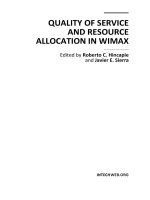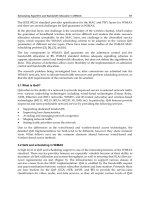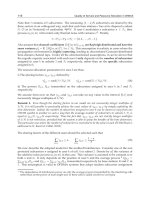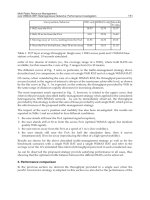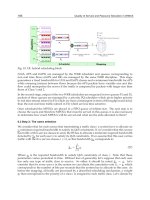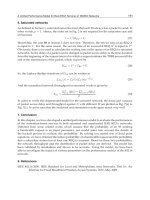Energy and resource optimization in building smart city using multiverse optimizer (mov) algorithm
Bạn đang xem bản rút gọn của tài liệu. Xem và tải ngay bản đầy đủ của tài liệu tại đây (2.94 MB, 100 trang )
VIETNAM NATIONAL UNIVERSITY HO CHI MINH CITY
HO CHI MINH CITY UNIVERSITY OF TECHNOLOGY
LÊ VĂN TRỌNG
ENERGY AND RESOURCE OPTIMIZATION IN
BUILDING SMART CITY USING MULTIVERSE
OPTIMIZER (MOV) ALGORITHM
Major: CONSTRUCTION MANAGMENT
Major code: 8580302
MASTER’S THESIS
HO CHI MINH CITY, July 2023
THIS THESIS IS COMPLETED AT
HO CHI MINH UNIVERSITY OF TECHNOLOGY – VNU – HCM CITY
Supervisor: Associate Prof. Pham Vu Hong Son
Examiner 1: Dr. Nguyen Anh Thu
Examiner 2: PhD. Nguyen Van Tiep
This master’s thesis is defended at HCM city University of Technology,
VNU-HCM City on 12th, July, 2023.
Master’s Thesis Committee:
1. Chairman
Associate Prof. Do Tien Sy
2. Secretary
Associate Prof. Luong Duc Long
3. Examiner 1
Dr. Nguyen Anh Thu
4. Examiner 2
PhD. Nguyen Van Tiep
5. Member
Dr. Nguyen Thanh Viet
Approval of the Chairman of the Master’s Thesis Defense Council and the
Dean of faculty of Civil Engineering after the thesis being corrected.
CHAIRMAN OF THE COUNCIL
DEAN OF FACULTY OF CIVIL ENGINEERING
i
VIETNAM NATIONAL UNIVERSITY
HO CHI MINH CITY
HO CHI MINH CITY UNIVERSITY
OF TECHNOLOGY
SOCIALIST REPUBLIC OF VIETNAM
Independence – Freedom - Happiness
THE TASK SHEET OF MASTER’S THESIS
Full name: LÊ VĂN TRỌNG
Student code: 2192017
Date of birth: 26/01/1992
Place of birth: HCM city
Major : Construction Management
Major code : 8580302
I. THESIS TOPIC: Energy and Resource Optimization in Building Smart City
Using Hybrid-Multiver Optimizer (MOV) Algorithm.
Tối Ưu Năng Lượng Và Tài Nguyên Trong Xây Dựng Thành Phố Thông Minh
Sử Dụng Thuật Toán Lai Đa Vũ Trụ (MVO).
II. TASKS AND CONTENTS: Energy optimisation artificial intelligence (Ai) in
construction management.
III. TASKS STARTING DATE : October 2022.
IV. TASKS ENDING DATE : August 2023.
V.
INSTRUCTOR : Associate Professor Pham Vu Hong Son
HCM City, August 2023
INSTRUCTOR
HEAD OF DEPARTMENT
Pham Vu Hong Son
DEAN OF FACULTY OF CIVIL ENGINEERING
ii
ACKNOWLEDGEMENT
First and foremost, I would like to show my appreciation to my enthusiastic thesis
instructor and advisor, Ph.D./Associate Prof. Pham Vu Hong Son, for his invaluable
guidance and unwavering support throughout this research journey. His expertise,
constructive feedback, and insightful suggestions have played a pivotal role in
guiding and give me direction for my thesis from begging to the end. I am extremely
appreciative for his devotion, persistence, and willingness to share his knowledge,
which have greatly enriched my understanding of the subject matter. I am fortunate
to have had the opportunity to work under his mentorship, and I extend my heartfelt
thanks for his valuable contributions to this research.
iii
ABSTRACT
The increasing demand for clean and efficient energy for construction industry,
especially for developing and managing smart cities has led to the development of
microgrids. Common problems with these strategies are the demand and supply of
the energy constantly conflicted, as a result, the energy usage frequently inefficient.
To solve this problem, optimization techniques and heuristics methods are utilized.
Mathematical optimization procedures can acquire optimum results, but they are
only suitable for small-scale problems. For large-scale situation, artificial
intelligence techniques have been applied. In this thesis, a Hybrid version of the
multi-verse optimizer (MVO) and the Sine Cosine Algorithm (SCA) is introduced to
advance the exploration and exploitation balance of the standard MVO algorithm.
The proposed hybrid algorithms also find improved optimal solutions for energy
optimization by illustrating its searching ability with diverse search space problems.
As a result, the proposed algorithm will demonstrate its availability to solve real
unknown search space construction and non-construction problems.
Keywords: Energy management, Hybrid multi-verse optimizer (MVO), Artificial
intelligent, Smart city.
iv
TÓM TẮT LUẬN VĂN THẠC SĨ
Nhu cầu ngày càng tăng về năng lượng sạch và hiệu quả trong ngành xây dựng, đặc
biệt là cho việc phát triển và quản lý các thành phố thông minh, đã dẫn đến việc phát
triển các mạng lưới nhỏ. Vấn đề phổ biến với các chiến lược này là sự xung đột giữa
nhu cầu và cung cấp năng lượng, dẫn đến việc sử dụng năng lượng thường không
hiệu quả. Để giải quyết vấn đề này, các kỹ thuật tối ưu hóa và phương pháp thơng
minh được áp dụng. Các quy trình tối ưu hóa tốn học có thể đạt được kết quả tối ưu,
nhưng chúng chỉ phù hợp với các vấn đề quy mô nhỏ. Đối với các tình huống quy mơ
lớn, các kỹ thuật trí tuệ nhân tạo đã được áp dụng. Trong luận văn này, một phiên
bản Hybrid của thuật toán tối ưu hỗn hợp multi-verse (MVO) và thuật toán Sine
Cosine (SCA) được giới thiệu để cải thiện sự cân bằng giữa việc khám phá và khai
thác của thuật toán MVO tiêu chuẩn. Các thuật tốn hybrid được đề xuất cũng tìm
kiếm các giải pháp tối ưu cải thiện cho việc tối ưu hóa năng lượng bằng cách minh
họa khả năng tìm kiếm của nó với các vấn đề khơng gian tìm kiếm đa dạng. Kết quả
là, thuật toán đề xuất sẽ chứng minh tính khả thi của nó trong việc giải quyết các vấn
đề xây dựng và không xây dựng trong không gian tìm kiếm thực sự.
Từ khóa: Quản lý năng lượng, Tối ưu hỗn hợp multi-verse (MVO), Trí tuệ nhân tạo,
Thành phố thông minh.
v
AUTHOR’S COMMITMENT
The undersigned below:
Name
: Le Van Trong
Student ID
: 2192017
Place and date of born
: Ho Chi Minh City, 26th January 1992.
Address
: 687 Lac Long Quan, Ward 10, Tan Binh District,
Ho Chi Minh City.
With this declaring that the master thesis entitled “Energy And Resource
Optimization in Building Smart City Using Multiverse Optimizer (MOV)
Algorithm” is done by the author under supervision of the instructor. All works,
ideas, and material that was gain from other references have been cited in the
corrected way.
Ho Chi Minh City, August 06 2023
Le Van Trong
vi
TABLE OF CONTENTS
THE TASK SHEET OF MASTER’S THESIS .................................................................... i
ACKNOWLEDGEMENT ....................................................................................................... ii
ABSTRACT ............................................................................................................................ iii
TÓM TẮT LUẬN VĂN THẠC SĨ ......................................................................................... iv
AUTHOR’S COMMITMENT ................................................................................................. v
TABLE OF CONTENTS...................................................................................................... vi
LIST OF FIRGURES ............................................................................................................ viii
1.
INTRODUCTION ........................................................................................................ 1
1.1.
Research Problem ...................................................................................................... 1
1.2.
Research Objectives: ................................................................................................ 7
1.3.
Scope of study ......................................................................................................... 10
1.4.
Research Methodology ............................................................................................ 12
1.5.
Academic and Practical Significances .................................................................... 14
2.
LITERATURE REVIEW ........................................................................................... 15
2.1.
Definition of Smart City .......................................................................................... 15
2.2.
Energy/Resource optimization in Construction ...................................................... 16
2.3.
Energy Optimization in Smart city construction. .................................................... 17
2.4.
Problem Dimension: ................................................................................................ 19
2.4.1.
Problem Dimension: ............................................................................................ 19
2.4.2.
Constraints: .......................................................................................................... 20
2.4.3.
Objective Function............................................................................................... 21
2.5.
Related Studies: ....................................................................................................... 22
2.6.
Research Gap:.......................................................................................................... 25
3.
MODEL DEVELOPMENT ........................................................................................ 30
3.1.
Multiverse Optimizer (MVO) ................................................................................. 30
3.2.
Sine Cosine Algorithm (SCA)................................................................................. 36
3.3. Hybrid Multiverse – Sincos Algorithm (hMVO) for Smart city construction energy
cost effective optimization ................................................................................................. 41
3.3.1.
Cost effective optimization .................................................................................. 41
3.3.2.
Hybrid Multiverse – Sincos Algorithm (hMVO) ................................................ 42
3.3.3. Hybrid Multiverse – Sincos Algorithm (hMVO) for Smart city construction
energy cost effective optimization ..................................................................................... 44
4.
MODEL VALIDATION............................................................................................. 47
vii
4.1.
Case Study 1: ........................................................................................................... 47
4.2.
Case Study 2: ........................................................................................................... 52
5.
CONCLUSION AND RECOMMENDATION .......................................................... 56
5.1.
Conclusion ............................................................................................................... 56
5.2.
Recommendation: .................................................................................................... 59
5.2.1.
Demonstration Projects, networking and education: ........................................... 59
5.2.2.
Government Incentives and Policies ................................................................... 60
5.2.3.
Research and Development ................................................................................. 61
5.3.
Future Research ....................................................................................................... 62
5.4.
Research Implication ............................................................................................... 63
5.4.1.
Practical implication ............................................................................................ 63
5.4.2.
Academic implication .......................................................................................... 64
REFERENCES....................................................................................................................... 66
APPENDICES ....................................................................................................................... 71
MVO.py ............................................................................................................................. 72
MVO_SCA.py.................................................................................................................... 72
Model ................................................................................................................................. 74
Constant.py ........................................................................................................................ 75
Main_run.py ....................................................................................................................... 76
Show result ......................................................................................................................... 79
Run_mvo.py ....................................................................................................................... 79
Run_mvo_sca.py ................................................................................................................ 80
Utils.py ............................................................................................................................... 80
Case 1 output:..................................................................................................................... 83
Case 2 output:..................................................................................................................... 85
PROFILE ............................................................................................................................... 87
viii
LIST OF FIRGURES
Figure 1-1. Energy Optimization in smart city project ............................................................ 5
Figure 1-2. Research objectives ............................................................................................... 7
Figure 1-3. Scope of study ..................................................................................................... 10
Figure 1-4. Research Flowchart ............................................................................................. 12
Figure 3-1. Conceptual model of the proposed MVO algorithm. ......................................... 31
Figure 3-2. Wormhole existence probability (WEP) versus travelling distance rate (TDR) . 32
Figure 3-3. Flow chart of MVO. ........................................................................................... 35
Figure 3-4. Effects of Sine and Cosine regarding equation (12) and equation (13) on the next
position. . ................................................................................................................................ 37
Figure 3-5. Sine and cosine with range of [−2,2]. ................................................................ 38
Figure 3-6. Sine and cosine with the range in [−2,2] allow a solution to go around (inside the
space between them) or beyond (outside the space between them) the destination. ............ 39
Figure 3-7: The model gradually reduces the range of the Sine and Cosine functions. ........ 39
Figure 3-8. Flow chart of MVO ............................................................................................. 41
Figure 3-10. Flowchart of Hybrid Multiverse–Sincos Algorithm (hMVO) algorithm .......... 43
ix
Figure 4-1. Wind plants, PV plants, and CHP as DERs (Distributed Energy Resources) .... 48
Figure 4-2. Convergence graph at Hour 17 for Case 1. ......................................................... 51
x
LIST OF TABLES
Table 2-1. List of related studies .................................................................................24
Table 4-1. Required power for each hour of case 1 [19]. ...........................................48
Table 4-2. The power generation of each renewable energy source per hour [19].....49
Table 4-3. Cost coefficients of DERs in microgrid in case 1 [19] . ............................49
Table 4-4. Generation power schedule and its cost generate by CMVO ....................50
Table 4-5. Generation power schedule and its cost generate by hMVO ....................50
Table 4-6. Statistic results for each algorithm performance Case 1. ..........................51
Table 4-7. Required power for each hour of case 2 ....................................................52
Table 4-8. The power generation of each renewable energy source per hour Case 2.53
Table 4-9. Generation power schedule and its cost generate by CMVO. ...................53
Table 4-10. Generation power schedule and its cost generate by hMVO ...................54
Table 4-11. Statistic results for each algorithm performance Case 2. ........................54
xi
LIST OF ABBREVIATIONS
AEC
Architecture, engineering, and construction
AHA
Artificial hummingbird algorithm
AI
Artificial Intelligence
ANN
Artificial neural network
BREEAM
Building Research Establishment Environmental Assessment Method
CEM
Construction engineering and management
CHP
Combine heat and power plant
DE
Differential evolution
DERs
Distributed energy resources
ES
Evolution strategy
GA
Genetic Algorithms
hMVO
Hybrid Multi-Verse Optimization Algorithm
LCA
Life Cycle Assessment
LEED
Leadership in Energy and Environmental Design
MVO
Hybrid Multi-Verse Optimization Algorithm
OF
Objective Function
PSO
Particle Swarm Optimization
PV
Solar power plant
SCA
Sine Cosine Algorithm
TDR
Travelling distance rate
WEP
Wormhole existence probability
WP
Wind plant
1
1. INTRODUCTION
§
In this chapter, the research problem is introduced, emphasizing the
significance of optimizing power schedules to minimize generation costs.
Section 1.1 provides a concise overview of power schedule optimization,
while Section 1.2 outlines the research objectives. The scope of the study is
presented in Section 1.3, after that an explanation of the research
methodology is discussed in Section 1.4. The academic and practical
significances of the research are addressed in Section 1.5, concluding this
chapter.
1.1. Research Problem
Smart cities utilize advanced technology and innovative solutions to address
urban challenges, leading to enhanced quality of life, prosperity, and sustainability.
As a result, smart cities are better equipped to handle challenges compared to
conventional cities. Global Data’s review of smart city history traces the first smart
city back to Amsterdam, which established a virtual digital city in 1994. IBM's
"Smarter Cities" marketing initiative launched in 2008, and the Smart City Expo
World Congress commenced in Barcelona in 2011, becoming an annual event
charting smart city development worldwide. The European Commission also created
the Smart Cities Marketplace in 2012 to centralize urban initiatives within the
European Union. Presently, more than 165 cities from 80 countries are participating
in smart city projects in various capacities.
A smart city encompasses a wide array of elements, necessitating a strategic and
systematic approach for effective implementation. The strategic framework of a
smart city comprises a hierarchical system encompassing vision, core values, and
strategic goals. The vision outlines the future smart cities aim to achieve, and core
values and strategic goals are derived from this vision. However, smart city
development varies among cities, leading to differing goals and evaluation criteria in
project execution.
2
Reviewing previous smart city studies reveals trends and weaknesses in
strategies. While research on smart cities has increased significantly, many studies
only focus on the application of smart technologies like Big Data and ICT or present
case-specific anecdotes, lacking a consistent and systematic strategic approach. To
ensure efficient resource allocation and utilization, smart city development should
prioritize selection and concentration. However, current research tends to be
fragmented and technology-focused, lacking a comprehensive framework for setting
effective strategic goals.
Energy resources optimization is a key component of sustainable construction
practices in smart city projects. Construction managers play a vital role in planning,
designing, and executing construction projects with a focus on reducing energy
consumption, optimizing energy use, and integrating renewable energy sources.
Energy-Efficient Building Design which stage construction managers are involved in
making decisions related to building design and material selection. By considering
energy-efficient building design principles and technologies, they can optimize
energy use and reduce operational costs throughout the building's lifecycle.
Construction Equipment and Energy Management is where managers can
contribute to energy resources optimization by efficiently managing construction
equipment and machinery. They can schedule equipment usage to avoid energy
wastage and explore the use of energy-efficient machinery. Construction managers
also can conduct life cycle cost analysis to evaluate the long-term costs and benefits
of different energy resource optimization strategies. This analysis helps in making
informed decisions about energy-efficient technologies and practices.
Construction engineering and management (CEM) is a specialized field that
utilizes project management principles to supervise the entire lifecycle of
construction projects, encompassing tasks such as planning, design, construction, and
maintenance. [1]. Nevertheless, there are limit or none plan of quantity and schedule
resources use in the project planning, execution and management phases.
Furthermore, the primary aim of CEM is to effectively meet the triple constraint of a
project, which includes ensuring adherence to designated timelines, managing costs
3
within budgetary limits, and upholding high standards of quality, all while
prioritizing the safety of all involved parties. [2]. CEM is categorized within the
architecture, engineering, and construction (AEC) sector, which ranks among the
largest industries globally, encompassing expenses surpassing USD 1.2 trillion every
year. However, despite its significant scale, the AEC industry faces challenges in
productivity, with more than 98% of projects encountering cost overruns and
numerous other difficulties. [3]. The industry face dynamic challenges such as
inefficient project resource management, resulting in a high level of uncertainty that
impedes productivity growth. Industry leaders face significant difficulties in
predicting and increasing its productivity.
Many construction projects aim for green building certifications such as LEED
(Leadership in Energy and Environmental Design) or BREEAM (Building Research
Establishment Environmental Assessment Method). Construction managers play a
significant role in meeting the criteria for these certifications, which often include
energy efficiency targets. Efficient energy resources optimization may lead to
reduced construction waste generation, as well-designed buildings and processes can
minimize material wastage. Construction managers can implement waste
management strategies that align with energy-efficient practices.
The application of advanced data analytics techniques, such as machine learning
and artificial intelligence, enhances power efficiency in construction projects. By
analyzing historical energy consumption data and project-specific factors, predictive
algorithms can forecast energy needs accurately. This foresight allows construction
managers to adjust energy usage proactively, optimize schedules, and allocate
resources efficiently, thereby reducing energy waste and expenses.
Energy resources optimization often involves the integration of smart
technologies, such as smart meters, sensors, and automation systems. Construction
managers need to understand and coordinate the deployment of these technologies in
construction projects. Construction managers may be involved in the integration of
renewable energy sources, such as solar panels or wind turbines, into construction
projects. This includes assessing the feasibility, cost, and benefits of renewable
energy adoption.
4
After construction is complete, construction managers can contribute to energy
resources optimization by ensuring the efficient operation and maintenance of
buildings and infrastructure, including monitoring energy consumption and
implementing energy-saving measures.
The increasing demand for clean and efficient energy for construction industry,
especially for developing and managing smart cities has led to Microgrid
development which refers to the establishment of small-scale power systems that
have the capability to operate autonomously or in collaboration with the primary
electricity grid. Common problems with these strategies are the demand and supply
of the energy constantly conflicted, as a result, the energy usage frequently inefficient
[4]. To solve the problem, optimization techniques and heuristics methods are
utilized. Mathematical optimization procedures can find optimal solutions, but they
are exclusively suitable for small-scale problems. For large-scale situation, artificial
intelligence techniques have been applied [5].
Construction managers may oversee the implementation of microgrid systems in
construction projects. Microgrids are localized power systems that can integrate
renewable energy sources and efficiently manage energy distribution, reducing
reliance on the main power grid.
In summary, energy resources optimization is an integral part of modern
construction management practices. Construction managers play a crucial role in
promoting sustainable and energy-efficient construction projects, from the planning
and design stages to project execution and facility management. Their decisions and
actions directly impact the energy performance and environmental footprint of
construction projects.
Here are several researches question this thesis will concentrate on:
1. How can we develop effective multi-objective optimization models that balance
conflicting objectives, such as minimizing energy costs, reducing greenhouse gas
emissions, and maximizing project efficiency, to achieve sustainable and efficient
construction outcomes?
5
2. How can advanced data analytics, including artificial intelligence, be leveraged to
predict energy needs and optimize energy usage in construction projects in smart
city?
3. What are the potential barriers and challenges in adopting and implementing
energy-efficient practices and technologies in the construction industry, and how
can these barriers be overcome?
Figure 1-1. Energy Optimization in smart city project
To optimize the power generation in a microgrid, a cost-effective and efficient
optimization algorithm is required. This thesis will propose Hybrid Multi-Verse
Optimization Algorithm (hMVO) in term of saving cost to optimize the power
generation in a microgrid. The proposed HMVO algorithm is compared with other
meta-heuristic algorithms such as MVO, Particle Swarm Optimization (PSO),
Artificial hummingbird algorithm (AHA), and Genetic Algorithms (GA), using two
different scale microgrids to assess the performance of proposed algorithms
regarding both cost reduction and execution time improvement.
There have been many studies that focusing on optimizing power generation in
microgrids using optimization algorithms. One such work is " Role of optimization
6
techniques in microgrid energy management systems—A review " by Gokul, S et al.
(2022). The authors provide a comprehensive review of the different metaheuristic
optimization algorithms that have been used to optimize microgrid energy
management. The review includes Genetic Algorithms, Particle Swarm Optimization,
Ant Colony Optimization, and others [6].
Another relevant work is " Microgrid Energy Management using Improved
Reinforcement Learning with Quadratic Programming " by Shu, Y, Dong, W, Yang,
Q, & Wang, Y. (2021). The authors present a decent examination of various
optimization approaches employed for microgrid control and energy management.
The analysis encompasses traditional optimization methods like Linear Programming
and Quadratic Programming, as well as metaheuristic techniques such as Genetic
Algorithms and Particle Swarm Optimization. [7].
In addition, there have been several works that focus specifically on the MultiVerse Optimization Algorithm (MVO) for power generation optimization in
microgrids. One such work is " Improved multi-verse optimizer feature selection
technique with application to phishing, spam, and denial of service attacks " by
Alzaqebah, M, Jawarneh, S, Mohammad, R, Alsmadi, M & Almarashdeh, I (2021)
The authors apply the MVO algorithm to optimize the operation of a microgrid with
renewables and energy storage systems [8].
Despite the availability of several works related to the topic, there are still
several issues that need to be focused on researching and solving. One such issue is
the scalability of the optimization algorithms to larger and more complex microgrids.
Most of the existing works have focused on small-scale microgrids with only a few
energy sources. However, as microgrids become more widespread and complex, the
optimization algorithms need to be able to handle a larger number of energy
distribution resource and its storages system.
Another issue is the sturdiness of the optimization algorithms in the face of
uncertain and dynamic conditions. The power generation in a microgrid is subject to
various uncertainties such as weather conditions and demand fluctuations. The
optimization algorithms need to be able to adapt to these uncertain and dynamic
conditions in real-time to ensure optimal power generation.
7
Finally, there is a need for the integration of multiple optimization objectives
such as cost, reliability, and environmental impact. Most of the existing works have
focused on optimizing a single objective such as cost or power generation. However,
in reality, there are multiple objectives that need to be considered when optimizing
microgrid power generation. Therefore, there is a need for the development of multiobjective optimization algorithms that can balance these different objectives.
1.2. Research Objectives:
The development of
the hybrid Multiverse
Optimization (hMVO)
Evaluate the
performance of the
hMVO algorithm in
different case studies
Apply the hMVO
algorithm to new case
study
Identify and analyze
the potential barriers
and challenges in
adoption and
implementation of
energy-efficient
practices and
technologies in the
construction industry
Figure 1-2. Research objectives
The first objective of this thesis is to develop and implement multi-objective
optimization models that effectively balance conflicting objectives in construction
projects, considering factors such as energy costs, greenhouse gas emissions, and
project efficiency, to achieve sustainable and efficient outcomes. Optimizing the
development of the Hybrid Multi-Verse Optimization (hMVO) algorithm by
analyzing different optimization techniques and heuristics methods to obtain the most
efficient and cost-effective approach for power generation in microgrids. This
research objective concentrates on the development of the hMVO algorithm for
8
power generation in microgrids. It highlights the importance of evaluating different
optimization techniques and heuristics methods to identify the most efficient and
cost-effective approach. To achieve this objective, the researcher may conduct a
literature review of existing optimization techniques and heuristics methods used in
power generation in microgrids. They may then evaluate the strengths and
weaknesses of each method and determine which ones are best suited for developing
the hMVO algorithm. The researcher may also need to conduct simulations and
experiments to test the efficiency and cost-effectiveness of the different optimization
techniques and heuristics methods. By comparing the results of these tests, the
researcher can identify the most effective approach to optimize the power generation
in microgrids and develop the hMVO algorithm. Overall, this research objective is
important as it aims to develop an optimized algorithm for power generation in
microgrids that is both efficient and cost-effective, which could have significant
implications for the renewable energy industry.
This thesis also aims to explore and apply advanced data analytics techniques,
via artificial intelligence, to analyze construction project data and predict energy
needs accurately as well as assess the result and performance of the hMVO algorithm
in different case studies, by comparing the results with those obtained by other
different meta-heuristic algorithms such as MVO, PSO, AHA, and GA. Evaluating
the performance of the hMVO algorithm in different case studies is important to
demonstrate its effectiveness and superiority over other commonly used optimization
algorithms. By comparing the results with those obtained by other meta-heuristic
algorithms such as MVO, PSO, AHA, and GA, this thesis can provide a
comprehensive analysis of the strengths and weaknesses of each algorithm. This
comparison can help researchers and practitioners to identify the most suitable
algorithm for their specific microgrid optimization problem, based on factors such as
cost, efficiency, and execution time. Additionally, the comparison can help to
establish the superiority of the hMVO algorithm, thus providing a strong case for its
adoption in practical applications. Overall, the comparison between hMVO algorithm
with other meta-heuristic algorithms is a crucial step in demonstrating its
effectiveness and practicality for power generation optimization in microgrids.
9
After that, this thesis will aim to apply the hMVO algorithm to a new case
study in a smart grid environment, aiming to optimize the energy power generation
and reduce costs, while maintaining a high level of performance and reliability. This
objective involves applying the algorithm to a real-world problem and evaluating its
effectiveness in optimizing energy power generation and reducing costs while
ensuring high performance and reliability.
Identifying and analyzing the potential barriers and challenges hindering the
widespread adoption and implementation of energy-efficient practices and
technologies in the construction industry is crucial for promoting sustainable and
environmentally responsible construction practices. This investigation involves a
comprehensive examination of factors that impede the integration of energy-efficient
measures in construction projects. Researchers conduct thorough literature reviews,
engage with key stakeholders, analyze energy consumption data, assess available
technologies, and evaluate economic and regulatory aspects. By understanding these
barriers, such as high initial costs, lack of awareness, resistance to change, and
limited technical expertise, effective strategies and solutions can be proposed to
foster the successful integration of energy-efficient practices in the construction
sector. Ultimately, addressing these challenges will lead to significant environmental
benefits and enhance the industry's contribution to energy conservation and
sustainable development.
10
1.3. Scope of study
Conduct development of hHMVO algorithm using
existing case study with same criteria
The results of existing case study will be
compared with other meta-heuristic algorithms
Apply new hMVO to produce optimal energy
solution for new case study.
Figure 1-3. Scope of study
The aim of this thesis is to examine and analyze the obstacles impeding the
widespread adoption and implementation of energy-efficient practices and
technologies in construction projects within smart cities. The construction industry's
role in smart city development is critical, but achieving energy efficiency poses
challenges. The study encompasses articles of various publication dates, gathered
from reputable databases such as Science Direct, SCOPUS, Web of Science, and
others, using relevant keywords like "energy efficiency," "smart cities," "construction
project management," and "sustainable construction." Additionally, credible journal
articles, books, and reports were consulted to compile an exhaustive list of barriers.
Understanding and analyzing these challenges are pivotal in proposing effective
strategies to overcome the impediments and facilitate the successful integration of
energy-efficient measures in smart city construction projects. By addressing these
barriers, the construction industry can significantly contribute to the overall
sustainability and efficiency of smart city development, promoting a greener, more
sustainable future and enhancing the quality of life for city residents.
This study aims to collect data from experienced professionals in the
construction project management field within smart cities to investigate barriers
11
hindering the widespread adoption of energy-efficient practices and technologies.
The selected industry experts should have at least a decade of experience in tactical
roles in the construction industry, while academic respondents will be chosen from
reputable management and engineering institutes with expertise in energy efficiency
in smart cities in this case is from Binh Dương smart city construction project.
Through analyzing the data provided by these experts, the primary obstacles to
implementing energy-efficient measures in smart city construction projects will be
identified, and their interrelationships will be examined. Based on the findings,
recommendations will be proposed to overcome these challenges and facilitate the
successful integration of energy-efficient practices and technologies in smart city
construction project management, thereby contributing to the development of
sustainable and eco-friendly smart cities.
Firstly, the algorithm development scope involves conducting a literature
review of different optimization methods and heuristics approaches to develop the
Hybrid Multi-Verse Optimization (hMVO) algorithm. The performance of the
hMVO algorithm will be compared with other meta-heuristic algorithms such as
MVO, PSO, AHA, and GA.
Secondly, the hMVO algorithm will be applied to each case study, and the
results will be compared with other meta-heuristic algorithms. The cost reduction and
execution time improvement of the hMVO algorithm in both case studies will be
evaluated.
Lastly, the smart grid optimization scope involves selecting a new case study
in a smart grid environment. The hMVO algorithm will be applied to optimize energy
power generation and reduce costs while maintaining high performance and
reliability. The results will be compared with other meta-heuristic algorithms, and the
efficiency and usefulness of the hMVO algorithm in the smart grid context will be
evaluated.
12
1.4. Research Methodology
Literature Review
Define problem statement related to smart city, construction energy
optimization
Define input data from case studies
Develop Hybrid MVO
Apply method for hMVO algorithm
Input data with similar criteria with original case study
Produce Hybrid MVO Algorithm
Validate performance of Hybrid MVO algorithm with
performance and results of other algorithms in the original case
study
Application of the new Hybrid MVO Algorithm
Apply new Hybrid MVO Algorithm to new case study to evaluate
new algorithm performance.
Conclusion, line out some limitation & suggestion for future further
research.
Figure 1-4. Research Flowchart
The research methodology for this study involves five key steps. The first step
is to conduct a comprehensive review of relevant literature on smart cities,
construction energy optimization, and energy-efficient practices in construction
project management. In which this section will focusing on analyze existing research,
case studies, and publications to gain insights into the current state of energy
optimization in smart city construction projects and identify gaps in knowledge.
Following by defining the research problem, focusing on the challenges and barriers
faced in achieving energy efficiency in construction projects within smart cities as



